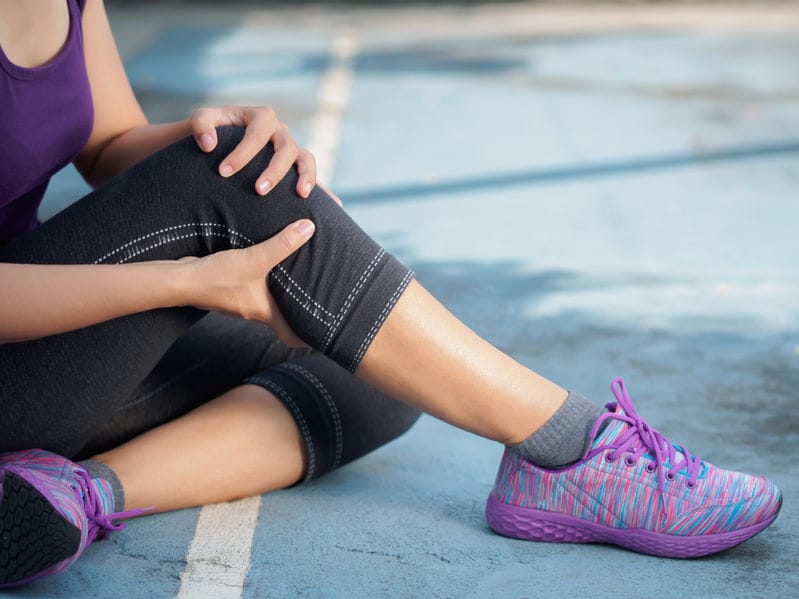Knee pain sucks.
And while the cause of knee pain can vary, getting stronger is usually a good way to get rid of—or at least, reduce—knee pain.
Getting stronger is awesome.
Getting stronger generally ends up meaning that you can move more freely, do more stuff and all with little to no pain. Hooray!
What’s tricky is that knee pain can also really get in the way of getting stronger. Squats hurt. Split squats (stationary lunges) hurt…which means getting up from and down to the floor hurts…which means any life activity that might ask you to get up from or down to the floor hurts…
Knee pain sucks.
There’s good news, though!
(What now? Good news?)
There are ways to modify how you do certain exercises that will reduce (or, ideally, eliminate, over time) the discomfort in your knees while you’re working out! And, that means you can get stronger and avail yourself of the joys of moving more freely with less pain!
Before we dive into all that, I need to highlight that just about everything I know about training around knee pain, I learned from Dan Pope, physical therapist extraordinaire (who is also my go-to for physical therapy referrals). Yay, Dan!
In today’s post, we’re going to focus on two foundational exercises—the squat and the split squat (or stationary lunge)—because they are both great for building strength in the muscles that prevent knee pain while simultaneously being the exercises most likely to aggravate your knee pain.
One big key here is reducing the amount of knee flexion. Full-range squats and split squats (and lunges and step-ups) all tend to involve quite a bit of knee-bending. For those experiencing some knee pain, deep knee bends tend to be a sure-fire way to bring on some pain. So, the revolutionary idea here is not to eliminate knee-bending entirely, but to move in ranges of motion that don’t cause pain.
[As an aside, there are times and places where avoiding pain entirely isn’t necessarily helpful in the long run…but that’s a nuanced conversation that we can save for another day).
Let’s start with squats.
Squats
When it comes to adjusting your squat technique, here are three simple guidelines you can play with to find what works best for your knees and they all kind of boil down to ways of reducing knee bend.
Widen your stance
It all depends on you and your specific situation, but sometimes simply widening your stance can change things enough for you train squats without bothering your knees.
Don’t go as low
We often use a box as a consistent depth guide for these. Again, a slight reduction in squat depth means your knees might not move into the part of the range of motion where the pain kicks in.
Keep your hips back
Most often, squats involve your knees translating forward as your hips move back. It’s kind of an accordion-like movement. The forward movement of the knees can be more stressful on the knees. For those with knee pain, we can adjust the squat technique to keep the knees from moving forward by sending the hips back.
In the video below, we use a band around the knees to encourage the hip shift and a box for consistent depth.
Split Squats
The split squat is literally like a squat that’s split to allow you to place more focus on one leg at a time. There are some pretty distinct advantages to training your legs this way…but this can also potentially mean moreknee stress. Conveniently, the strategies for adjusting your technique here are somewhat similar to those for squats.
Don’t go as low
In place of the box, yoga blocks provide an easy and adjustable (and relatively soft) way of giving your knee a depth-guide. This will limit knee flexion on both legs.
Lengthen your stance AND lean forward
For the most part, the focus of the split squat is on the front leg. For some types of knee pain, the back kneeends up being the one that feels the most challenged.
Lengthening your stance (and this doesn’t have to be a huge lengthening) and then leaning your torso forward can serve to reduce the stress on the back knee while making it easier to keep your front knee’s range of motion under control.
Of course, your mileage may vary. It usually takes a bit of exploration and experimentation to find the technique adjustment that works best for you. Once you find it, however, you can begin to progress the resistance so that you can get stronger…which will, ideally, lead to feeling like you can move more freely and do more cool stuff.





